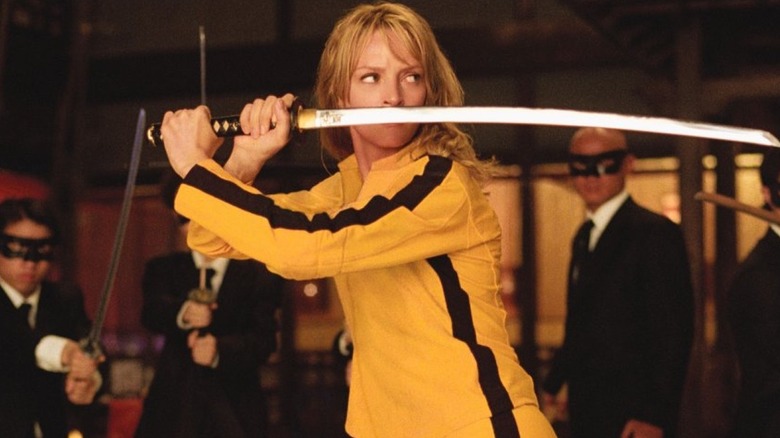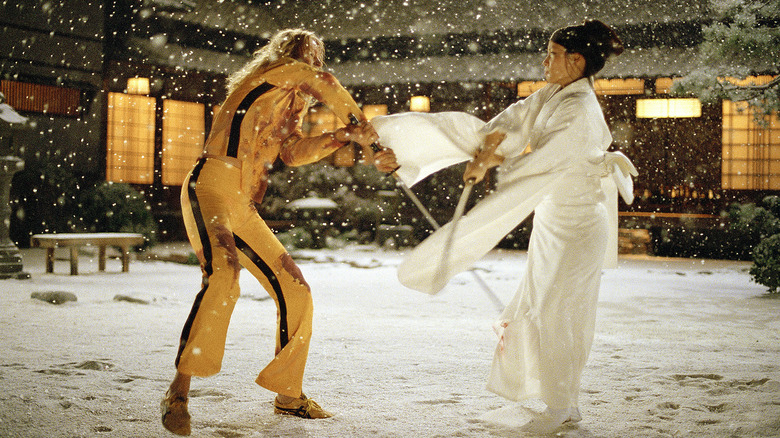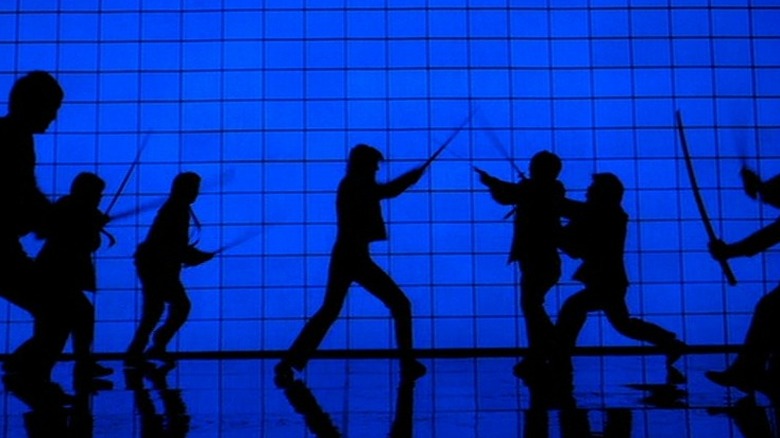The Risk Of Failure Drove Quentin Tarantino To Create Kill Bill
When a filmmaker writes and directs their own script, they run the risk of comparing their strengths and weaknesses. Take Zack Snyder — few would say he can wield a pen as well as he can a camera. On the flip side, there's Joss Whedon; his writing has shaped pop culture, for better or worse, but his visual craftsmanship never grew beyond 1990s network TV.
Quentin Tarantino is aware of this dichotomy and it has motivated him to push himself as an artist. In the wake of his breakout run in the 1990s, "Reservoir Dogs," "Pulp Fiction," and "Jackie Brown," Tarantino was especially praised for his dialogue. With conversations littered with pop culture ephemera, Tarantino's characters don't sound much like real people, but they certainly argue like them. Unlike many other writers famous for stylized dialogue (see the aforementioned Whedon), he gives all of his characters distinct voices too.
But Tarantino felt limited by this praise: "It was like, 'Am I the director that I want to be?" Or do you just do what you've done before because that was just fine? 'You write really good dialogue. Stick with that, buddy. But stay out of [great, cinematic directors'] park, because ultimately you can't cut it." That's why he decided to make "Kill Bill," to see if he could cut it as a great filmmaker, not just a great writer.
'I've always adored action filmmakers'
Speaking to Rolling Stone in 2003, Tarantino called "Kill Bill," "[His] first action movie." Here's where we make an important distinction between violence and action; Tarantino's films always had the former, but not the latter. When guns are fired in "Reservoir Dogs" and "Pulp Fiction," it always happens in short bursts. The violence and bloodshed aren't meant to look especially cool, at least compared to the sword fights in "Kill Bill." The closest thing to action in the former two movies is the chase scene in "Reservoir Dogs" when Mr. Pink (Steve Buscemi) flees the police. "Jackie Brown," on the other hand, has no action and little violence, which helps explain why Tarantino swung hard in the opposite direction for his next film.
Tarantino explained why he went to action to buff up his filmmaking bona fides. As he put it:
"I've always adored action filmmakers. And those are actually what I consider the real cinematic directors. And so if I'm going to throw my hat in that ring, I want to be one of the best that ever lived. I don't want to do an OK job. I want to rock everybody's f***ing world."
Tarantino is also a known aficionado of Southeast Asian cinema. When listing his favorite movies from 1992 to 2009, he included Japanese action films such as "Battle Royale" and "The Blade." He recruited Sonny Chiba, a Japanese martial artist and genre star, to cameo in "Kill Bill." The finale of "Kill Bill Volume 1," where the Bride (Uma Thurman) and O-Ren Ishii (Lucy Liu) duel in the snow, resembles "Lady Snowblood." With these influences, it makes sense that when Tarantino set out to make an action movie, he wound up making a samurai movie.
The ceiling of your talent
When trying something new, you always risk failing. When doing so publicly, the potential fallout is magnified threefold. Quentin Tarantino directed "Kill Bill" not in spite of that risk, but because of it. He explained to Rolling Stone: "I have an expression that I call "hitting your head on the ceiling of your talent. I wanted to find out where that ceiling was for me. I actually wanted to risk failing."
"Kill Bill" was split into two movies; knowing why Tarantino made the movie helps explain his structural decisions. The action is front-loaded in "Volume 1," from the opening where the Bride kills Vernita Green/Copperhead (Vivica A. Fox) to the bloody spectacular finale, where the Bride invades the House of Blue Leaves with the intention to kill O-Ren, slaughtering her entire Yakuza organization along the way. "Volume 2," on the other hand, is closer to Tarantino's usual oeuvre, relying more on dialogue-driven suspense. In any case, Tarantino's risk paid off; "Kill Bill" was a financial and critical success.
After "Kill Bill," I'd argue that Tarantino has made only one other pure action movie: "Django Unchained," a Spaghetti Western set in the antebellum south. Tarantino is known for unconventional story structure, so seeing him tell a straightforward hero's journey like "Django" practically becomes subversive. Though ultimately heavier on the talking than the shooting, "Inglourious Basterds" comes close to an action movie as well.
Even if he didn't totally reinvent himself, Tarantino definitely took the lessons about how to make violence look cool from "Kill Bill."


